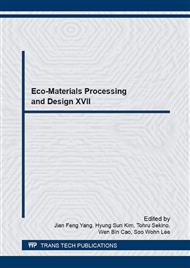p.1
p.6
p.12
p.18
p.23
p.28
p.33
p.38
Mechanical Recovery of Ni/Al2O3 Nanocomposites after Pre-Oxidations at High Temperatures
Abstract:
Ni/Al2O3 nanocomposites have a crack healing function which results in recovery of mechanical strength. The function is caused by oxidations of Ni particles within matrix. Oxidation of Ni dispersion also results in the evolution of oxidized zone, which consists of NiAl2O4 grains in Al2O3 matrix. Degradations by high-temperature oxidation before introduction of surface crack is necessary to investigate for estimating the life time of the present material system. Samples of Ni/Al2O3 nanocomposites were prepared by using pulsed electric current sintering and pre-oxidized at 1200°C for 1-6 d in air. Surface cracks were given by the Vickers indentation at 49 N for 10 s. The samples were oxidized again at 1200°C for 6 h in air to heal the surface cracks. Longer pre-oxidation time of samples results in degradation of the performance of surface crack disappearance. Bending strength of healed samples with 2 d pre-oxidation was comparable with the samples before cracks introduction. After oxidation at 1200°C for 6 h in air, the partially disappearance of cracks was observed on 6 d pre-oxidized samples. Hence, the recovery of bending strength depends on thickness of oxidized zone and depth of surface cracks.
Info:
Periodical:
Pages:
12-17
Citation:
Online since:
August 2016
Authors:
Keywords:
Price:
Сopyright:
© 2016 Trans Tech Publications Ltd. All Rights Reserved
Share:
Citation:


